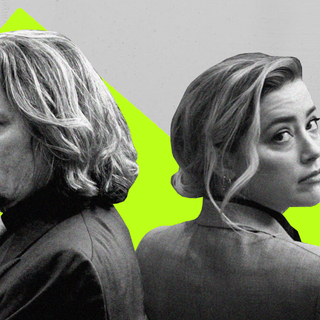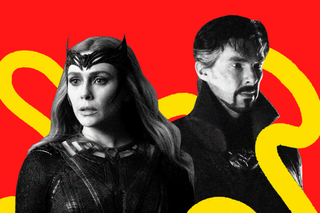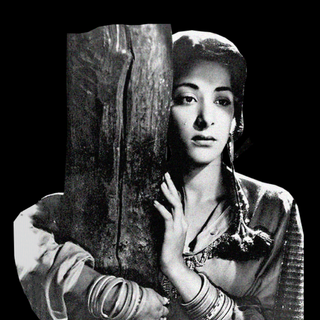
In ‘Multiverse of Madness,’ Grief Lies at the Heart of Horror
The movie is both about Wanda’s grief of motherhood and Stephen’s grief of powerlessness, but it remains caged within a templatized franchise.

If you knew there was a universe, where you were happy, wouldn’t you want to go there?
Wanda Maximoff — the Scarlet Witch caped in red robes and regalia — doesn’t find this a laborious ask. Happiness lives in her mind, but grief presses on her reality. Wanda (Elizabeth Olsen) is acting “reasonably” when she is willing to bend realities and travel universes to reunite with her children; for Doctor Strange (Benedict Cumberbatch), reason means saving the multiversal realities. “I’m not a monster, I’m just a mother,” she says, seconds after whirling balls of magic have killed a whole battalion. The hurly-burly is just starting; the battle both won and lost. The terror of witchy things, blood and gore, gargoyles and rubble dominates the next 100 odd minutes of Doctor Strange in the Multiverse of Madness (2022)
The sequel to Doctor Strange (2016), Multiverse of Madness (MoM) always intended to be a horror movie. But it comes as no surprise that the movie has splintered fans and critics alike along the lines of just how terrorizing the movie is. Should it come with a PG-13 rating? Does it align with the genre’s narrative arc?
The degree of MoM’s scare and shock is currently contested; but a reasonable conclusion to draw is there are several horror genre motifs creeping into the corners of the movie. There are zombies; one-eyed, tentacled monsters; bloodshed; death; bodies clawing their way out of pools of blood; jump scares; a book of dark spells; a haunted house; even Beethoven’s classic Symphony No. 5 in C minor that scores the tension in the unfolding terror. A dead superhero’s cadaver resurrects into a zombie; he wears a cape except it is one made of shrieking apparitions. This is horror fiction — just one playing out through universes.
There’s then something common between what has happened in the Marvel Cinematic Universe (MCU) so far and the horror genre. In some ways, Multiverse of Madness attempts healing via the genre; the horror has indeed always mirrored the binding nature of grief. The horror might just have been the right choice here; but the sequel labors under the weight of a franchise so vast, so tangled that it fails to stand as anything but a supernatural mess.
In this case, the tidal wave of grief washes away at the muck and the gore. If MoM is a story of madness, then it is also a story of grief. Much has precipitated the storyline: half of the population died in Infinity Wars, the said half was resurrected in Endgame. In the meantime, Wanda had to kill her partner Vision in the interest of the universe; and later drew on her power “to blot out the trauma of her many unbearable losses,” effectively erasing the lives of a whole community to imagine the people she loved. Wanda’s grief of motherhood stands at odds with Stephen’s yearning for time and love lost.
Related on The Swaddle:
What Makes Us Want to Watch Scary Movies?
The genre is fertile ground for people to deep dive into their pain and injuries, instead of escaping it; “it validated what I was feeling, and wove it into a larger tapestry of the uncanny and supernatural, things that can’t be explained away, that shouldn’t exist in our world but do,” as Gus Moreno, a horror fiction enthusiast, wrote. Most horror movies start with someone’s death, a grim loss; think of the specter of a family moving into a newly-vacant house that later turns out to be haunted. The plot is thrilling, but hiding between the rasps of the creaking door is an elongating shadow of pain.
That’s one of the nuggets of wisdom in the genre, Moreno argued. “Yes, your pain is real. Yes, it can’t get much worse than this. Yes, you have every right to be scared. But the underlying metaphor in horror is that you are always capable of handling more than you could have ever imagined.” In that sense, horror fiction is incredibly empowering in granting people agency to hurt — and heal.
Arguably, MoM does chart some of the narrative arcs of horror fiction. It starts with an underlying message (loss and longing) and depicts a tragedy to symbolize personal grief. There is terror, revulsion, and dread. A reconciliation of the characters — internally and externally — as they seem to make peace with this world. Even in MoM, grief comes full circle; the Scarlet Witch meets an alternate version of Wanda Maximoff who forgives the barbarity and bloodshed. Healing is given the same space as gothic terror. The resolution comes with love and a realization; “Grateful for its tribulations, at least we don’t have to go through it alone,” Sorcerer Supreme Wong notes at one point.
Then, MoM fits within what some would call “cosmic horror.” The notion was proposed by American author H. P. Lovecraft — a marriage between horror and weird fiction. The cosmic dread threads the science fiction with horror; people toggle between dangerous knowledge and madness to create a scenario where nature is “eroded.” The element of the supernatural and incomprehensible pain, which inspires more than shock, is ever-present in MoM. “Through the multiverse they go, crashing through various distorting and dreamlike mirrors — a cosmic labyrinth in which Strange and Wanda, in particular, will come face to face with a doppelgänger or two,” as L.A. Times noted. With it, MoM also poses questions about fate and human decency.
The true stakes that lie at the heart ofhorror arebest depicted in a scene towards the end of the film, when (spoiler!) X-Men’s Professor Charles Xavier makes a cameo as the head of the Illuminati (the absurdity lives within the franchise). Both Xavier and Wanda have the power of telekinesis; he walks through Wanda’s mind and finds her real, uncorrupted self plunged deep away. The mindscape is very Waiting for Godot-esque; a lonely, isolated road stretches with only one single tree in sight. A mist of red creeps on Xavier as he attempts to free her, the music climbs to a high-pitched shriek, and the Witch crawls out of it to snap his neck from the back, killing the professor. Wanda’s grief had emboldened a horror so debilitating, that it smothers the person and the pursuit of her rescue.
Related on The Swaddle:
Have Superheroes Become Culturally Obsolete?
And just like every horror story, nothing is ever truly resolved. Grief does come full circle, but remains loyal to the genre in allowing terror to always linger within.
The marriage of horror and grief is one suited for MoM. But the whole saga feels futile; since the pursuit falls in the backdrop of clumsy action scenes and lines. The movie is both about Wanda’s grief of motherhood and Stephen’s grief of powerlessness, but it remains caged within a templatized franchise. MCU, just like other franchises of its stature — Lucas Films, DC — is built on familiar grounds. The action plays out like a well-rehearsed dance, with the viewer almost expectant of what is to come next. While MoM does attempt to undress the action and instead let it sway in robes of dread and panic, it does succumb to the untiring mission of the franchise.
“I have to say that this infinite profusion of realities does not actually feel all that different in practice from the shapeshifting, retconning world of all the other Avengers films,” Peter Bradshaw noted in The Guardian. “And infinite realities tend to reduce the dramatic impact of any one single reality, and reduces what there is at stake in a given situation.” Even A.A. Dowd agreed in Rolling Stone when he said: “Raimi, for his part, behaves like a diabolical spirit, possessing the movie whenever he can with ghoulish cartoon-horror mayhem. There’s plenty of him in this film, at least in spurts; he really puts the corpse into the exquisite corpse storytelling model Marvel has nourished.”
The signs can also be traced in the token scene of female superhumans fighting with each other; Peggy Carter (the First Avenger in another universe) and Maria Rambeau (alternate version of Captain Marvel) fight with Scarlet Witch. This is an echo of Avengers: Infinity War; when the women bandy together to fight a mad God. The irony is morbid and disappointing when one realizes that all the original women in MCU have now died — including Wanda Maximoff. It’s almost like despite the fertility of the horror genre and women’s pain, the movie was forced to color within the lines.
“The problem with Marvel and DC adaptations, however, is that there is very little context to these stories. There is almost no narrative that speaks to the particular anxieties of the present moment,” Rohitha Naraharisetty noted in The Swaddle. Context is indeed important in horror fiction too; the human drama at the very start binds the viewer and the narrative in a sacrosanct relationship, pushing them to care about the madness on screen. Ardent MCU fans — scholars with the wisdom of WandaVision (2020), What If…?, Doctor Strange, Spider-Man: No Way Home, and Avengers — would be better placed to look for this context. Arguably, WandaVision sowed the seeds of empathy; in Wanda lay a sympathetic character the audience will be conflicted about while watching MoM.
But the backstory is still scattered and lying under the rubble of 24 movies, stripping the human component — the one critical to the horror pursuit — of its power. It is not hard to relate to Wanda’s grief, but it requires memory and energy to resurrect it in our minds.
The movie then lives and dies in a pool of paradoxes. There is horror, which inches dangerously close to repetition. There is a supernatural absurdity, which can also be interpreted as an unhelpful mess. But this multiversal expansion, amidst the occult rituals and expansively laid-out sanctums, manages to lay bare a truth part complex, part unnerving, but wholly devastating: Grief is madness.
Saumya Kalia is an Associate Editor at The Swaddle. Her journalism and writing explore issues of social justice, digital sub-cultures, media ecosystem, literature, and memory as they cut across socio-cultural periods. You can reach her at @Saumya_Kalia.
Related


Woe Is Me! “I’ve Lost Friends Since During the Pandemic. How Do I Get Them Back?”
